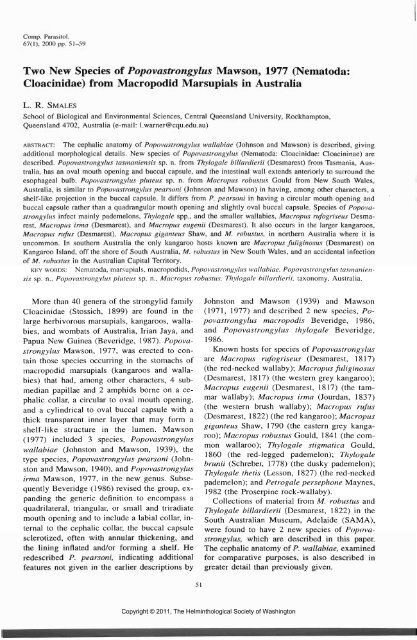Comparative Parasitology 67(1) 2000 - Peru State College
Comparative Parasitology 67(1) 2000 - Peru State College
Comparative Parasitology 67(1) 2000 - Peru State College
Create successful ePaper yourself
Turn your PDF publications into a flip-book with our unique Google optimized e-Paper software.
Comp. Parasitol.<br />
<strong>67</strong>(1), <strong>2000</strong> pp. 51-59<br />
Two New Species of Popovastrongylus Mawson, 1977 (Nematoda:<br />
Cloacinidae) from Macropodid Marsupials in Australia<br />
L. R. SMALES<br />
School of Biological and Environmental Sciences, Central Queensland University, Rockhampton,<br />
Queensland 4702, Australia (e-mail: l.warner@cqu.edu.au)<br />
ABSTRACT: The cephalic anatomy of Popovastrongylus wallabiae (Johnson and Mawson) is described, giving<br />
additional morphological details. New species of Popovastrongylus (Nematoda: Cloacinidae: Cloacininae) are<br />
described. Popovastrongylus tasmaniensis sp. n. from Thylogale billardierii (Desmarest) from Tasmania, Australia,<br />
has an oval mouth opening and buccal capsule, and the intestinal wall extends anteriorly to surround the<br />
esophageal bulb. Popovastrongylus pluteus sp. n. from Macropus robust us Gould from New South Wales,<br />
Australia, is similar to Popovastrongylus pearsoni (Johnson and Mawson) in having, among other characters, a<br />
shelf-like projection in the buccal capsule. It differs from P. pearsoni in having a circular mouth opening and<br />
buccal capsule rather than a quadrangular mouth opening and slightly oval buccal capsule. Species of Popovastrongylus<br />
infect mainly pademelons, Thylogale spp., and the smaller wallabies, Macropus rufogriseus Desmarest,<br />
Macropus irma (Desmarest), and Macropus eugenii (Desmarest). It also occurs in the larger kangaroos,<br />
Macropus rufus (Desmarest), Macropus giganteus Shaw, and M. robustus, in northern Australia where it is<br />
uncommon. In southern Australia the only kangaroo hosts known are Macropus fuliginosus (Desmarest) on<br />
Kangaroo Island, off the shore of South Australia, M. robustus in New South Wales, and an accidental infection<br />
of M. robustus in the Australian Capital Territory.<br />
KEY WORDS: Nematoda, marsupials, macropodids, Popovastrongylus wallabiae, Popovastrongylus tasmaniensis<br />
sp. n., Popovastrongylus pluteus sp. n., Macropus robustus, Thylogale billardierii, taxonomy, Australia.<br />
More than 40 genera of the strongylid family<br />
Cloacinidae (Stossich, 1899) are found in the<br />
large herbivorous marsupials, kangaroos, wallabies,<br />
and wombats of Australia, Irian Jaya, and<br />
Papua New Guinea (Beveridge, 1987). Popovastrongylus<br />
Mawson, 1977, was erected to contain<br />
those species occurring in the stomachs of<br />
macropodid marsupials (kangaroos and wallabies)<br />
that had, among other characters, 4 submedian<br />
papillae and 2 amphids borne on a cephalic<br />
collar, a circular to oval mouth opening,<br />
and a cylindrical to oval buccal capsule with a<br />
thick transparent inner layer that may form a<br />
shelf-like structure in the lumen. Mawson<br />
(1977) included 3 species, Popovastrongylus<br />
wallabiae (Johnston and Mawson, 1939), the<br />
type species, Popovastrongylus pearsoni (Johnston<br />
and Mawson, 1940), and Popovastrongylus<br />
irma Mawson, 1977, in the new genus. Subsequently<br />
Beveridge (1986) revised the group, expanding<br />
the generic definition to encompass a<br />
quadrilateral, triangular, or small and triradiate<br />
mouth opening and to include a labial collar, internal<br />
to the cephalic collar, the buccal capsule<br />
sclerotized, often with annular thickening, and<br />
the lining inflated and/or forming a shelf. He<br />
redescribed P. pearsoni, indicating additional<br />
features not given in the earlier descriptions by<br />
51<br />
Johnston and Mawson (1939) and Mawson<br />
(1971, 1977) and described 2 new species, Popovastrongylus<br />
macropodis Beveridge, 1986,<br />
and Popovastrongylus thylogale Beveridge,<br />
1986.<br />
Known hosts for species of Popovastrongylus<br />
are Macropus rufogriseus (Desmarest, 1817)<br />
(the red-necked wallaby); Macropus fuliginosus<br />
(Desmarest, 1817) (the western grey kangaroo);<br />
Macropus eugenii (Desmarest, 1817) (the tammar<br />
wallaby); Macropus irma (Jourdan, 1837)<br />
(the western brush wallaby); Macropus rufus<br />
(Desmarest, 1822) (the red kangaroo); Macropus<br />
giganteus Shaw, 1790 (the eastern grey kangaroo);<br />
Macropus robustus Gould, 1841 (the common<br />
wallaroo); Thylogale stigmatica Gould,<br />
1860 (the red-legged pademelon); Thylogale<br />
brunii (Schreber, 1778) (the dusky pademelon);<br />
Thylogale thetis (Lesson, 1827) (the red-necked<br />
pademelon); and Petrogale persephone Maynes,<br />
1982 (the Proserpine rock-wallaby).<br />
Collections of material from M. robustus and<br />
Thylogale billardierii (Desmarest, 1822) in the<br />
South Australian Museum, Adelaide (SAMA),<br />
were found to have 2 new species of Popovastrongylus,<br />
which are described in this paper.<br />
The cephalic anatomy of P. wallabiae, examined<br />
for comparative puiposes, is also described in<br />
greater detail than previously given.<br />
Copyright © 2011, The Helminthological Society of Washington
















